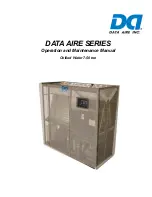
4.
Remove the drain plug (
G019428
Figure 16
1.
Drain plug
5.
When the oil has drained completely, lower the front
wheels to the ground, replace the drain plug, and
torque to 18 N-m (13 ft-lb).
Note:
Dispose of the used oil at a certified recycling
center.
6.
Remove the dipstick and slowly pour oil into the filler
hole until the oil level reaches the middle of the dipstick
(
).
7.
Replace and secure the dipstick.
8.
Wipe up any spilled oil.
9.
Connect the wire to the spark plug.
Cleaning the Sediment Cup
Service Interval:
Every 100 hours
DANGER
In certain conditions, gasoline is extremely
flammable and highly explosive. A fire or explosion
from gasoline can burn you and others and can
damage property.
•
Stop the engine and keep heat, sparks, and
flame away.
•
Handle fuel only outdoors.
•
Wipe up spills immediately.
•
Do not smoke while handling fuel.
1.
Shut off the engine and wait for all moving parts to
stop.
2.
Disconnect the wire from the spark plug.
3.
Move the fuel-shutoff valve to the O
FF
position.
4.
Remove the sediment cup and O-ring (
1
2
g020282
Figure 17
1.
O-ring
2.
Sediment cup
5.
Wash the sediment cup in a non-flammable solvent and
dry it thoroughly.
6.
Place the O-ring in the fuel valve and install the
sediment cup, tightening it securely.
7.
Move the fuel-shutoff lever to the O
N
position.
Note:
If any fuel leaks, repeat this procedure and
replace the O-ring.
Servicing the Spark Plug
Service Interval:
Every 100 hours—Inspect, clean, and
adjust the spark plug; replace it if
necessary.
Every 200 hours—Replace the spark plug.
Use an
NGK BPR6ES
spark plug or equivalent.
1.
Stop the engine and wait for all moving parts to stop.
2.
Disconnect the wire from the spark plug.
3.
Clean around the spark plug.
4.
Remove the spark plug from the cylinder head.
Important:
Replace a cracked, fouled, or dirty
spark plug. Do not clean the electrodes because
grit entering the cylinder can damage the engine.
5.
Set the gap on the plug to 0.76 mm (0.03 inch) (
16









































